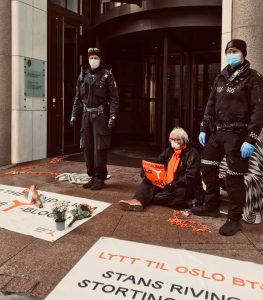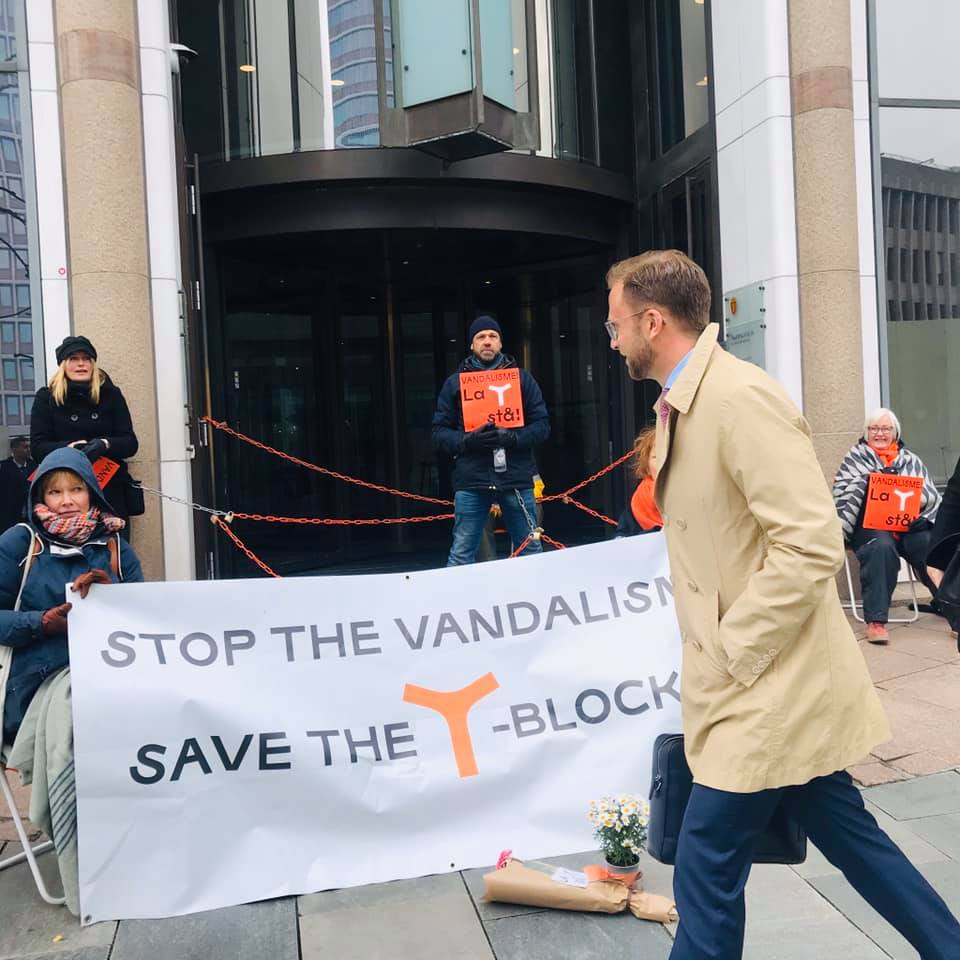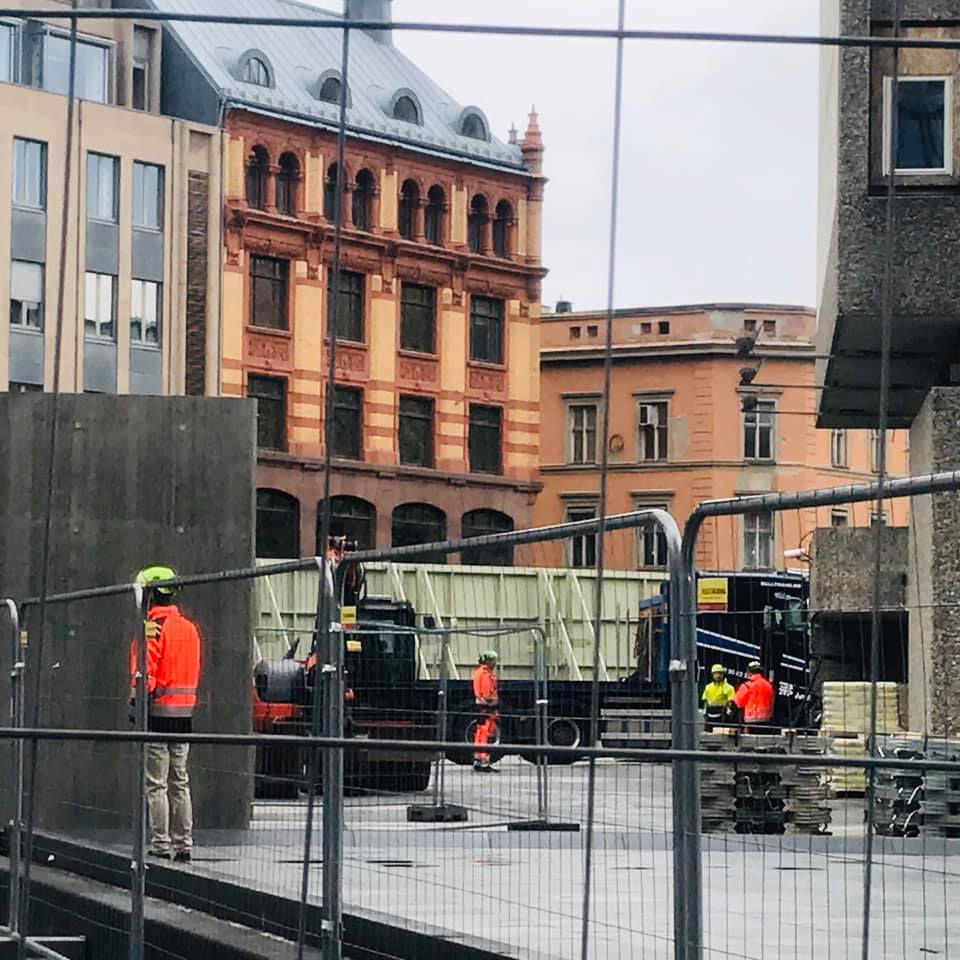(THIS ARTICLE IS MACHINE TRANSLATED by Google from Norwegian)
The fact that Oslo City Council last week advocated the preservation of the Y-block has not slowed down the destruction, rather the contrary. The peaceful demonstration in front of the endangered building on April 28 consisted of 8–9 people who had become stuck in contagious distance from each other.

The protesters sat on the cold tarmac for many hours holding up large posters demanding immediate protection of the Y-block: “Listen to the Oslo City Council. Stopped the demolition and allowed the Storting to handle the matter on May 12, “it was on a banner. Five of the protesters were led away, including Ellen de Vibe, former director of the Oslo Planning and Building Agency, and put on a smooth cell, says Hanne Sophie Claussen, head of The support action to preserve the Y block.
Demolition work is increasing
Full or partial preservation of the government quarter has been announced in the Storting on 12 May. The state has been sued in the demolition case, but that case does not come until autumn. Meanwhile, on the other side of the tall fence around the Y block, the container is filled with the building's unique fixtures. While five protesters were forcibly removed, Statsbygg drove unhindered into what unfortunately resembled the dreaded support blocks, the ones to be stacked under the end wall of the Y block, so it can be cut off.
As I write this, a picture of a Y-block with a large gaping wound, a screaming cavity in which Picassos and Nesjar's mural appear The fishermen has testified about Norwegian history and way of life. What if all persistent acts of preservation lead, but only when the murals are separated from their symbiotic association with the architectural lines, and the building and the art are amputated?

A brushstroke away from the protection plan
Erling Viksjø's bold buildings that create a balanced whole with integrated murals by Picasso and Nesjar are iconic. In June 2011, the entire Viksjøk quarter, Y included, was a stroke of luck from being included in the national protection plan. The papers were to be sent for signature at the National Antiquities after the summer, everyone agreed.
In the shelter of the terror bomb dust, before it had settled, the Y-block ended up in an unprotected and dangerous situation. The terrorist bomb had pointed to the possibility of change in the Hammersborg quarter. Had the bomb gone off a few months later, the building would have been as immeasurably legal as in its construction.
The building stood up to the terrorist attacks. Only windows and similar cosmetic details were damaged. The Y-block's construction was intact, not bomb-damaged, as the world press informed at the same time as Astrup granted a demolition permit. But the bomb damaged the idea of the historic importance of the building and the anchorage as a symbol of the surrounding welfare state and those who built it.
Y-block as a time witness
At a time when our society has actively embraced its inhabitants with measures to make us all as fully as possible through a pandemic, we have built even more relevance as a time-witness to facing challenges that require strength and unity. The virtue we all participate in costs. The cost of demolishing the Y-block with the implementation of a new government quarter has so far been estimated at a few and twenty billion NOK. Picasso's art is about to be cut loose. The value of the murals in their right context is invaluable and inalienable, as is Erling Viksjø's innovative architecturally clean buildings and the context of the surroundings.
Had the Y-block been privately owned, this could never have happened.
Had the Y-block been privately owned, this could never have happened. The national protection plan is designed to counteract the state's historically poor management of our cultural heritage. Hundreds of stave churches have been lost. The pier in Bergen, Bakklandet was saved for the twelfth hour. When has the twelfth hour come for the Y-block.

A living democracy
We are in a time of new challenging challenges. We are all asked to give up squeezing, meeting. Many have not said goodbye to their loved ones, nor attended the funeral. Losing hurts, but being deprived of the opportunity to grieve or remember is even more brutal. The fight for the Y-block is also about being allowed to remember even the worst.
At the same time, it is about a living democracy being allowed to have a city center where everyone is welcome, where not a small political elite favors at the expense of the people. The square meter price for the new government offices is now five times as high as all other offices, we can read in several newspapers. Co-location is no longer necessary. The money-consuming parliamentary garage has secured politicians and administration parking centrally.
Budget overruns and poor architecture
The cityscape does not become open, green and beautiful if the Y-block is demolished. The grossly manipulated images of the new government quarter have been torn apart and debated fiercely in social media for a long time. Budget overruns, construction stops, poor architecture and too tight stacking of buildings are the result. Security measures will affect and prevent the previously free flow of people in the city center, children's trains, the 8th march – all natural rallies or celebrations in the center of the capital are affected.
The terrorist attack was aimed at the then ruling party, and in a podcast, architecture professor Karl Otto Ellefsen communicates how one does not want to rebuild what the terror tore down, but wants something new and better. Therefore, the turns have been fast, and an alternative investigation with all or part preservation of the Y-block has never been carried out. The national protection plan was put on hold. A government plan for the government quarter seemed legitimate. There is only one problem with a state plan:
It rises above all legal and controlling bodies. This means that neither the Civil Ombudsman, the county governor, the National Antiquarian or others have the authority to review the state's plan. Precisely for this reason, state plans work brilliantly to build large projects such as national roads and other things one wants to speed up.
Let us be reminded that we are a resilient society, that together we are strong.
The state in the district court
That the state had been granted a demolition permit for the Y-block, but still had to meet in Oslo District Court at the end of March, may seem absurd to many. For anyone who struggled for conservation, this was the last chance, but also the first instance where it could be possible to be heard. The district court ruled that there was no reason to comply with the petition for interim relief and thus protect the Y-block from demolition before the trial takes place in the fall. No appeal will prevent the building from being demolished before this.
Berit Reiss Andersen, who led the case on behalf of the Fortime Memorial Association and NAL, fought with beak and claws in the district court. Ellen de Vibe wrote much of the evidence presented by the plaintiffs. Nothing helped; The state plan is unwavering also legal. Should we, as a democracy, set strict rules for when a state plan can be implemented? Yes absolutely.
The security was used as a pretext from the state, but this can be taken care of in other ways. A co-location has never been favorable to security, and it can be maintained in other ways. The Y-block and the location can be used for many things that do not challenge this.
Do not complete what the terrorist failed
The trauma after the terror has been tough for everyone, it's not too late to turn around. Do not complete what a terrorist failed. Let us be reminded that we are a resilient society, that together we are strong. That we have a government that listens to the people, which drops the prestige to restore the confidence in our democracy we all need.
The corona crisis has caused many governments to take control of the population at the expense of democracy. Let the preservation of the Y-block show that we have a society that gives way to what not everyone thinks is beautiful, but which is nevertheless an indispensable part of our survival history and resistance struggle against undemocratic methods in our country.
Transparency and a neutral and actionable body of appeal are something that has been missing all along in this process. Conservation activists have come together and demonstrated their support for the Y-block in the form of an engaging concert, torchlight and weekly staircase. The other party has used construction machines, concrete blocks and disinformation.
Europa Nostra, a cultural protection organization, has written to our prime minister without getting any answers. Following the U-turn of the city council, the Storting has to answer many things. In the name of democracy, let the Y-block stand.


